Dynamics and Determinants of Maize Sap Flow Under Soil Compaction in the Black Soil Region of Northeast China
Abstract
1. Introduction
2. Materials and Methods
2.1. Study Site
2.2. Experimental Design
2.3. Data Collection
2.3.1. Meteorological Data Collection
2.3.2. Determination of Soil Properties
2.3.3. Determination of Maize Morphological Variables
2.3.4. Monitoring of Soil Water Content and Sap Flow Rate
2.4. Statistical Analysis
3. Results
3.1. Soil Properties and Water Content as Related to Soil Compaction
3.2. Maize Morphological Variables as Related to Soil Compaction
3.3. Relationship Between Sap Flow Rates and Meteorological Variables
3.4. Relationship Between Sap Flow Rate and Maize Morphological Variables
3.5. Relationship Between Sap Flow Rate and Soil Compaction-Related Properties
4. Discussion
4.1. Effect of Meteorological Variables on Sap Flow Rate
4.2. Effect of Maize Morphological Variables on Sap Flow Rate Under Different Soil Compaction Treatments
4.3. Effect of Soil Compaction-Related Properties on Sap Flow Rate Under Different Soil Compaction Treatments
5. Conclusions
Author Contributions
Funding
Data Availability Statement
Acknowledgments
Conflicts of Interest
References
- Zhao, L.; He, Z.; Zhao, W.; Yang, Q. Extensive investigation of the sap flow of maize plants in an oasis farmland in the middle reach of the Heihe River, Northwest China. J. Plant Res. 2016, 129, 841–851. [Google Scholar] [CrossRef]
- Pieruschka, R.; Huber, G.; Berry, J.A. Control of transpiration by radiation. Proc. Natl. Acad. Sci. USA 2010, 107, 13372–13377. [Google Scholar] [CrossRef] [PubMed]
- Zhao, L.; Zhao, W. Canopy transpiration obtained from leaf transpiration, sap flow and FAO-56 dual crop coefficient method. Hydrol. Process. 2014, 29, 2983–2993. [Google Scholar] [CrossRef]
- Han, M.; Zhang, H.; DeJonge, K.C.; Comas, L.H.; Gleason, S. Comparison of three crop water stress index models with sap flow measurements in maize. Agric. Water Manag. 2018, 203, 366–375. [Google Scholar] [CrossRef]
- Cammalleri, C.; Rallo, G.; Agnese, C.; Ciraolo, G.; Minacapilli, M.; Provenzano, G. Combined use of eddy covariance and sap flow techniques for partition of ET fluxes and water stress assessment in an irrigated olive orchard. Agric. Water Manag. 2013, 120, 89–97. [Google Scholar] [CrossRef]
- Zhao, P.; Li, S.; Li, F.; Du, T.; Tong, L.; Kang, S. Comparison of dual crop coefficient method and Shuttleworth–Wallace model in evapotranspiration partitioning in a vineyard of northwest China. Agric. Water Manag. 2015, 160, 41–56. [Google Scholar] [CrossRef]
- Hou, L.; Wenninger, J.; Shen, J.; Zhou, Y.; Bao, H.; Liu, H. Assessing crop coefficients for Zea mays in the semi-arid Hailiutu River catchment, northwest China. Agric. Water Manag. 2014, 140, 37–47. [Google Scholar] [CrossRef]
- Capurro, M.C.; Ham, J.M.; Kluitenberg, G.J.; Comas, L.; Andales, A.A. A novel sap flow system to measure maize transpiration using a heat pulse method. Agric. Water Manag. 2024, 301, 108963. [Google Scholar] [CrossRef]
- Dugas, W.A. Comparative measurement of stem flow and transpiration in cotton. Theor. Appl. Climatol. 1990, 42, 215–221. [Google Scholar] [CrossRef]
- Dragoni, D.; Caylor, K.K.; Schmid, H.P. Decoupling structural and environmental determinants of sap velocity: Part II. Observational application. Agric. For. Meteorol. 2009, 149, 570–581. [Google Scholar] [CrossRef]
- Liu, B.; Zhao, W.; Jin, B. The response of sap flow in desert shrubs to environmental variables in an arid region of China. Ecohydrology 2011, 4, 448–457. [Google Scholar] [CrossRef]
- Xu, X.; Tong, L.; Li, F.; Kang, S.; Qu, Y. Sap flow of irrigated Populus alba var. pyramidalis and its relationship with environmental factors and leaf area index in an arid region of Northwest China. J. For. Res. 2011, 16, 144–152. [Google Scholar] [CrossRef]
- Zhang, Y.; Kang, S.; Ward, E.J.; Ding, R.; Zhang, X.; Zheng, R. Evapotranspiration components determined by sap flow and microlysimetry techniques of a vineyard in northwest China: Dynamics and influential factors. Agric. Water Manag. 2011, 98, 1207–1214. [Google Scholar] [CrossRef]
- Rankoth, L.M.; Udawatta, R.P.; Gantzer, C.J.; Jose, S.; Nelson, K.A. Cover crop effects on corn plant sap flow rates and soil water dynamics. Crop Sci. 2019, 59, 2227–2236. [Google Scholar] [CrossRef]
- He, Y.; Qiu, Z.; Liu, R.; Tang, M.; Wu, P. Impact of mulching on soil moisture and sap flow characteristics of jujube trees. Agronomy 2023, 13, 2799. [Google Scholar] [CrossRef]
- Qu, Y.; Kang, S.; Li, F.; Zhang, J.; Xia, G.; Li, W. Xylem sap flows of irrigated Tamarix elongata Ledeb and the influence of environmental factors in the desert region of Northwest China. Hydrol. Process. 2007, 21, 1363–1369. [Google Scholar] [CrossRef]
- Xia, G.; Kang, S.; Li, F.; Zhang, J.; Zhou, Q. Diurnal and seasonal variations of sap flow of Caragana korshinskii in the arid desert region of north–west China. Hydrol. Process. 2008, 22, 1197–1205. [Google Scholar] [CrossRef]
- Zhang, Z.; Tian, F.; Hu, H.; Yang, P. A comparison of methods for determining field evapotranspiration: Photosynthesis system, sap flow, and eddy covariance. Hydrol. Earth Syst. Sci. 2014, 18, 1053–1072. [Google Scholar] [CrossRef]
- Zhu, X.M.; Peng, W.; Ran, E.H.; Fu, M.L.; Zheng, Y.H.; Zhang, Y. Characteristics of spring maize sap flow and its environmental influencing factors in typical mollisol area. Chin. J. Appl. Ecol. 2023, 34, 921–927. [Google Scholar] [CrossRef]
- Xiao, D.; Yang, X.; Bai, H.; Tang, J.; Tao, F. Trends and climate response in the yield of staple crops across Northeast China. Front. Sustain. Food Syst. 2024, 7, 1246347. [Google Scholar] [CrossRef]
- An, T.; Schaeffer, S.; Zhuang, J.; Radosevich, M.; Li, S.; Li, H.; Pei, J.; Wang, J. Dynamics and distribution of 13 C-labeled straw carbon by microorganisms as affected by soil fertility levels in the Black Soil region of Northeast China. Biol. Fertil. Soils 2015, 51, 605–613. [Google Scholar] [CrossRef]
- Tang, Z.; Song, W.; Zou, J. Farmland protection and fertilization intensity: Empirical evidence from preservation policy of Heilongjiang’s black soil. J. Environ. Manag. 2024, 356, 120629. [Google Scholar] [CrossRef]
- Keller, T.; Sandin, M.; Colombi, T.; Horn, R.; Or, D. Historical increase in agricultural machinery weights enhanced soil stress levels and adversely affected soil functioning. Soil Tillage Res. 2019, 194, 104293. [Google Scholar] [CrossRef]
- Keller, T.; Or, D. Farm vehicles approaching weights of sauropods exceed safe mechanical limits for soil functioning. Proc. Natl. Acad Sci. USA 2022, 119, e2117699119. [Google Scholar] [CrossRef]
- He, H.; Dyck, M.F.; Si, B.C.; Zhang, T.; Lv, J.; Wang, J. Soil freezing–thawing characteristics and snowmelt infiltration in Cryalfs of Alberta, Canada. Geoderma Reg. 2015, 5, 198–208. [Google Scholar] [CrossRef]
- Starkloff, T.; Larsbo, M.; Stolte, J.; Hessel, R.; Ritsema, C. Quantifying the impact of a succession of freezing-thawing cycles on the pore network of a silty clay loam and a loamy sand topsoil using X-ray tomography. Catena 2017, 156, 365–374. [Google Scholar] [CrossRef]
- Mossadeghi-Björklund, M.; Arvidsson, J.; Keller, T.; Koestel, J.; Lamandé, M.; Larsbo, M.; Jarvis, N. Effects of subsoil compaction on hydraulic properties and preferential flow in a Swedish clay soil. Soil Tillage Res. 2016, 156, 91–98. [Google Scholar] [CrossRef]
- Obour, P.B.; Schjønning, P.; Peng, Y.; Munkholm, L.J. Subsoil compaction assessed by visual evaluation and laboratory methods. Soil Tillage Res. 2017, 173, 4–14. [Google Scholar] [CrossRef]
- Zhu, X.; Peng, W.; Xie, Q.; Ran, E. Effects of soil compaction stress combined with drought on soil pore structure, root system development, and maize growth in early stage. Plants 2024, 13, 3185. [Google Scholar] [CrossRef]
- Zhou, M.; Xiao, Y.; Li, Y.; Zhang, X.; Wang, G.; Jin, J.; Ding, G.; Liu, X. Soil quality index evaluation model in responses to six-year fertilization practices in Mollisols. Arch. Agron. Soil. Sci. 2020, 68, 180–194. [Google Scholar] [CrossRef]
- Campbell, G.S.; Norman, J.M. An Introduction to Environmental Biophysics; Springer: New York, NY, USA, 1998. [Google Scholar] [CrossRef]
- Klute, A. Methods of Soil Analysis. Part 1: Physical and Mineralogical Methods, 2nd ed.; American Society of Agronomy and Soil Science Society of America: Madison, WI, USA, 1986. [Google Scholar] [CrossRef]
- Merrill, S.D.; Black, A.L.; Bauer, A.; Upchurch, D.R. Theory of minirhizotron root directionality observation and application to wheat and corn. Soil Sci. Soc. Am. J. 1994, 58, 664–671. [Google Scholar] [CrossRef]
- Liao, R.; Bai, Y.; Liang, H.; An, S.; Ren, S.; Cao, Y.; Le, Z.; Lu, J.; Liu, J. Root growth of maize as studied with minirhizotrons and monolith methods. Arch. Agron. Soil. Sci. 2015, 61, 1343–1356. [Google Scholar] [CrossRef]
- Zhou, C.; Gu, D.; Zhao, P.; Huang, K.; He, W.; Yao, Y.; Zhu, L.; Huang, Y. Effect of sap flow radial variation on daily transpiration estimation of Eucalyptus urophylla× Eucalyptus grandis. Chin. J. Appl. Ecol. 2017, 28, 2445–2451. [Google Scholar] [CrossRef]
- Luo, H.; Dewitte, K.; Landschoot, S.; Sigurnjak, I.; Robles-Aguilar, A.A.; Michels, E.; Neve, S.D.; Haesaert, G.; Meers, E. Benefits of biobased fertilizers as substitutes for synthetic nitrogen fertilizers: Field assessment combining minirhizotron and UAV-based spectrum sensing technologies. Front. Environ. Sci. 2022, 10, 988932. [Google Scholar] [CrossRef]
- Jiang, X.; Kang, S.; Li, F.; Du, T.; Tong, L.; Comas, L. Evapotranspiration partitioning and variation of sap flow in female and male parents of maize for hybrid seed production in arid region. Agric. Water Manag. 2016, 176, 132–141. [Google Scholar] [CrossRef]
- Dynamax Flow 32-1K Sap Flow System. Available online: https://dynamax.com/products/transpiration-sap-flow/flow32-1k-sap-flow-system (accessed on 14 January 2016).
- Bengough, A.G.; McKenzie, B.M.; Hallett, P.D.; Valentine, T.A. Root elongation, water stress, and mechanical impedance: A review of limiting stresses and beneficial root tip traits. J. Exp. Bot. 2011, 62, 59–68. [Google Scholar] [CrossRef] [PubMed]
- Si, J.; Feng, Q.; Yu, T.; Zhao, C. Nighttime sap flow and its driving forces for Populus euphratica in a desert riparian forest, Northwest China. J. Arid Land. 2015, 7, 665–674. [Google Scholar] [CrossRef]
- Oliveira, P.D.; Sato, M.K.; Lima, H.V.; Rodrigues, S.; Silva, A.P. Critical limits of the degree of compactness and soil penetration resistance for the soybean crop in N Brazil. J. Plant Nutr. Soil Sci. 2016, 179, 78–87. [Google Scholar] [CrossRef]
- Chen, D.; Wang, Y.; Liu, S.; Wei, X.; Wang, X. Response of relative sap flow to meteorological factors under different soil moisture conditions in rainfed jujube (Ziziphus jujuba Mill.) plantations in semiarid Northwest China. Agric. Water Manag. 2014, 136, 23–33. [Google Scholar] [CrossRef]

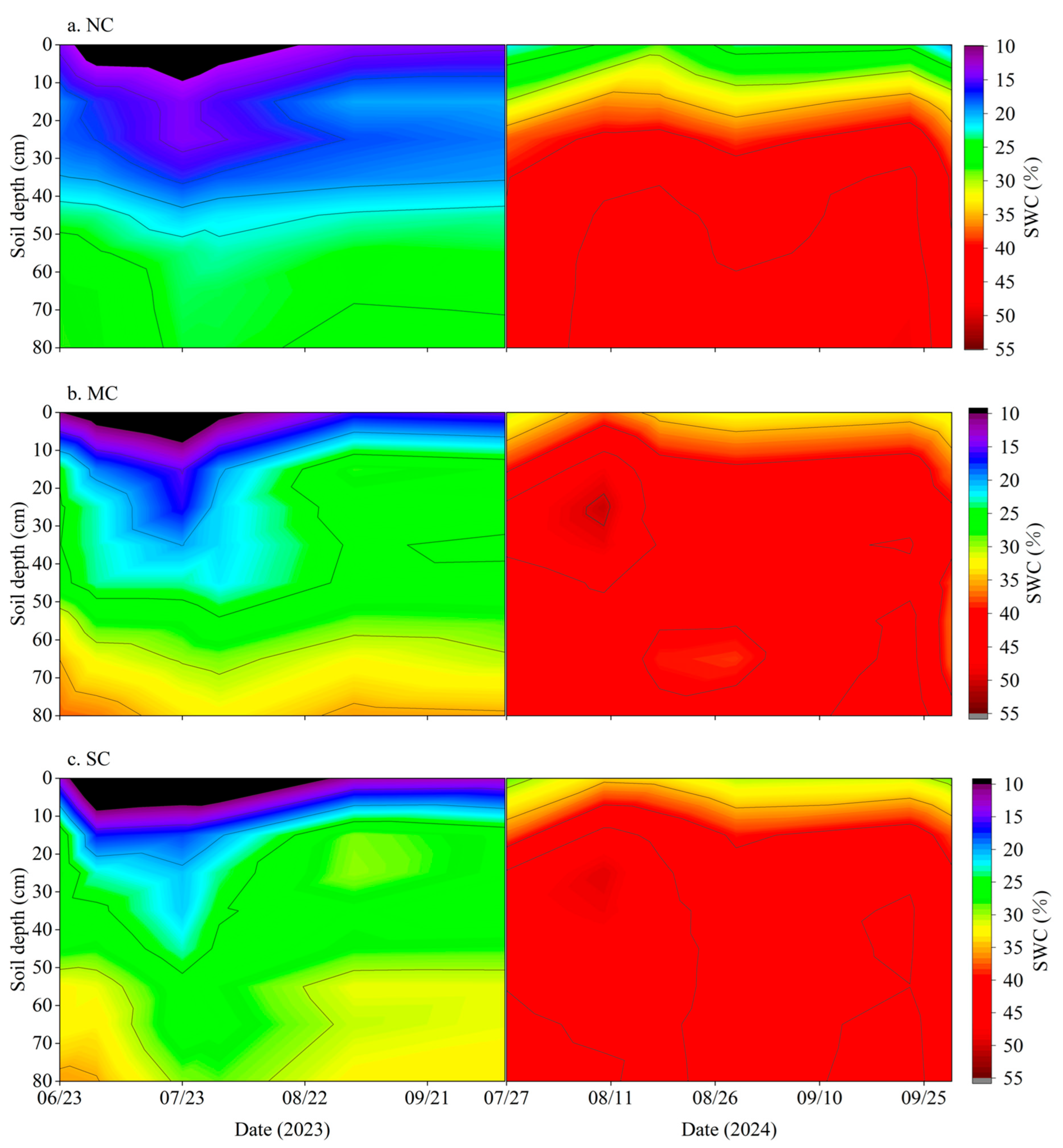
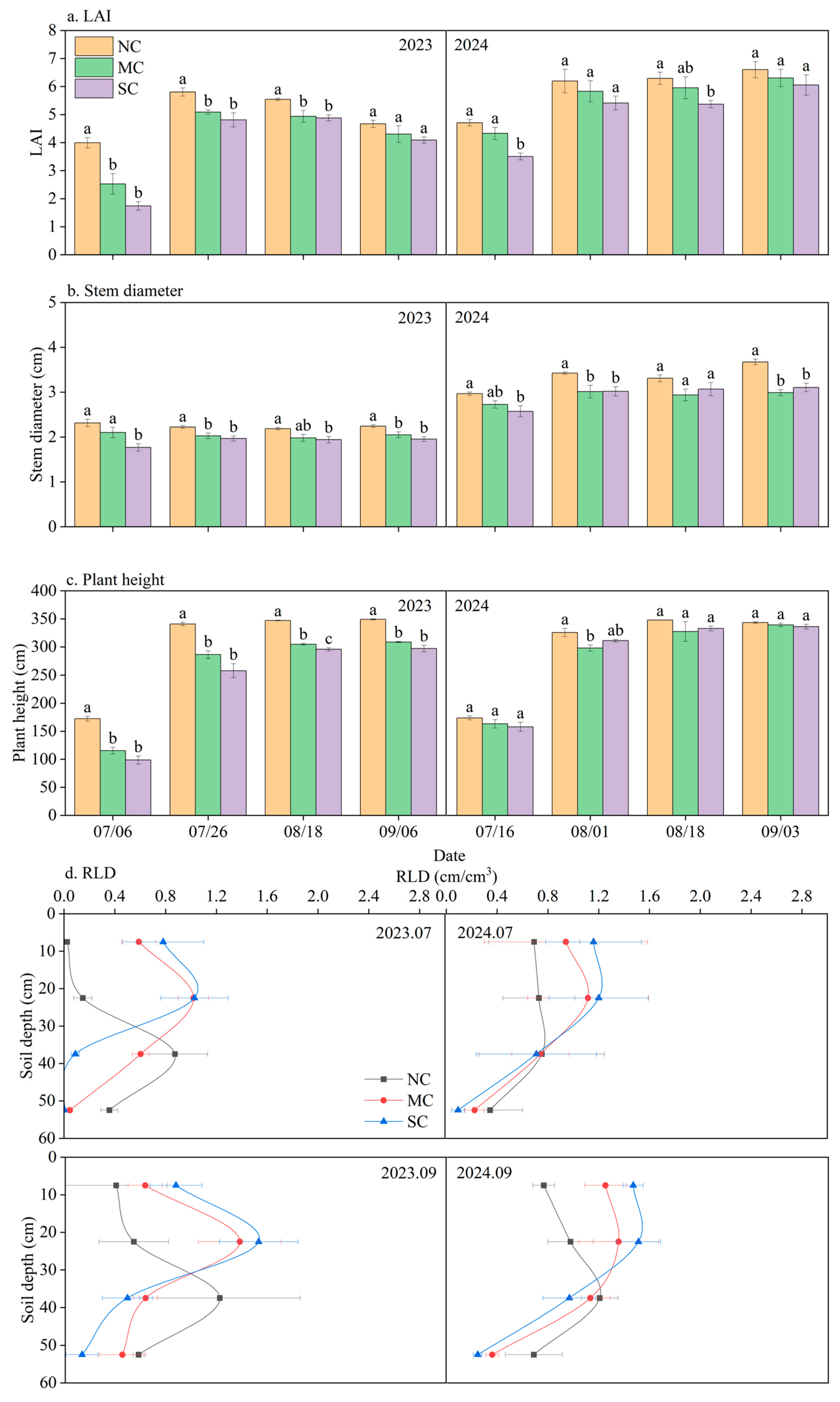
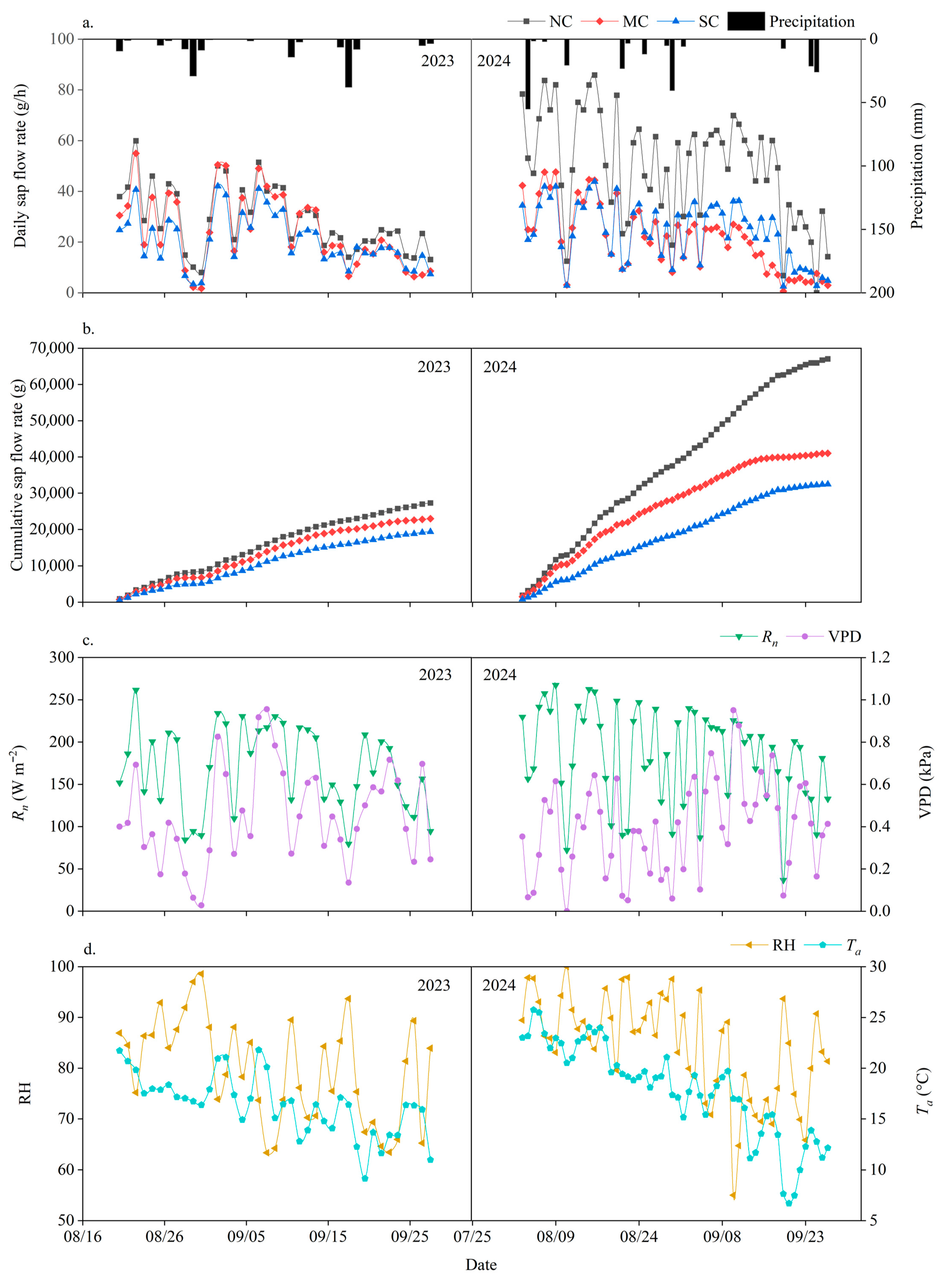
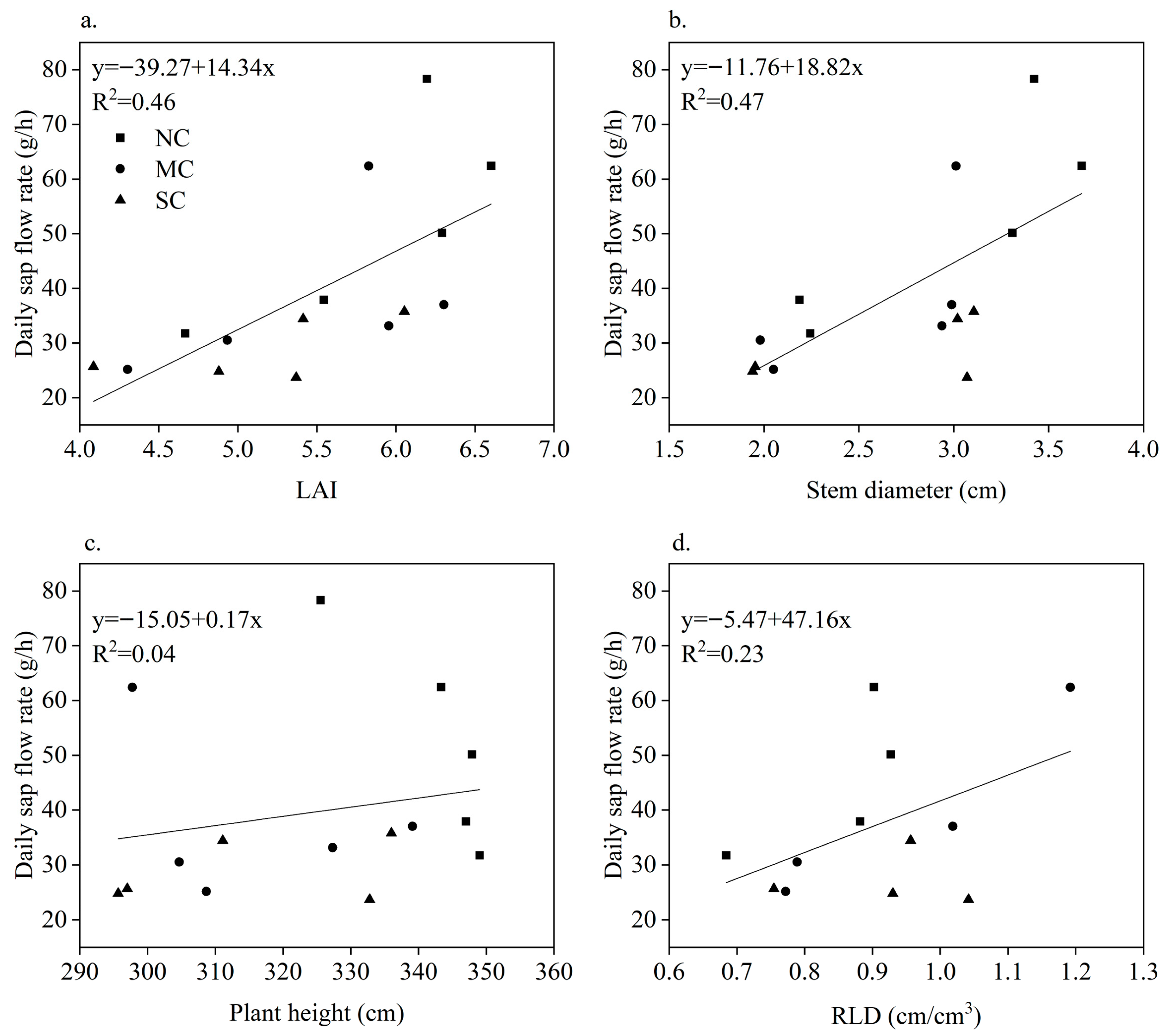
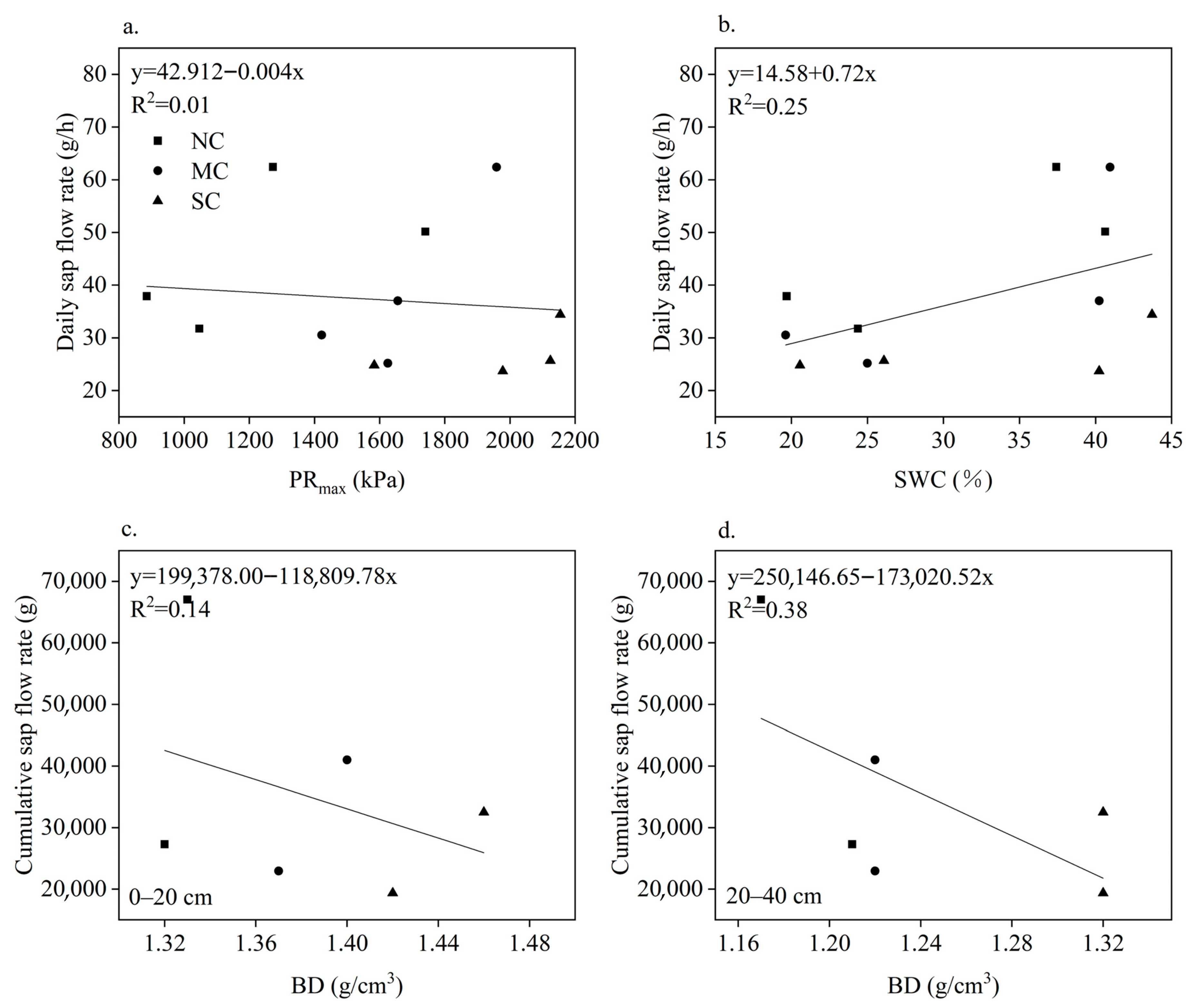
| Year | Soil Layer (cm) | Treatments | BD (g cm−3) | Ks (10−2 cm min−1) |
|---|---|---|---|---|
| 2023 | 0–20 | NC | 1.32 ± 0.02 b | 13.79 ± 0.11 a |
| MC | 1.37 ± 0.02 ab | 0.16 ± 0.03 b | ||
| SC | 1.42 ± 0.01 a | 0.10 ± 0.04 b | ||
| 20–40 | NC | 1.21 ± 0.01 b | 7.70 ± 0.05 a | |
| MC | 1.22 ± 0.01 b | 0.29 ± 0.08 b | ||
| SC | 1.32 ± 0.02 a | 0.06 ± 0.01 c | ||
| 2024 | 0–20 | NC | 1.33 ± 0.04 b | 7.53 ± 0.73 a |
| MC | 1.40 ± 0.01 ab | 0.11 ± 0.00 b | ||
| SC | 1.46 ± 0.02 a | 0.04 ± 0.00 b | ||
| 20–40 | NC | 1.17 ± 0.02 b | 7.60 ± 0.44 a | |
| MC | 1.22 ± 0.03 b | 0.33 ± 0.01 b | ||
| SC | 1.32 ± 0.03 a | 0.02 ± 0.00 c |
| Year | Time Scale | Treatments | U2 (m s−1) | Ta (°C) | RH | VPD (kPa) | Rn (W m−2) | N |
|---|---|---|---|---|---|---|---|---|
| 2023 | Hourly | NC | 0.412 ** | 0.693 ** | –0.703 ** | 0.817 ** | 0.886 ** | 936 |
| MC | 0.363 ** | 0.622 ** | –0.624 ** | 0.747 ** | 0.865 ** | |||
| SC | 0.395 ** | 0.628 ** | –0.660 ** | 0.758 ** | 0.902 ** | |||
| Daily | NC | –0.141 | 0.573 ** | –0.325 * | 0.649 ** | 0.851 ** | 39 | |
| MC | –0.152 | 0.525 ** | –0.347 * | 0.666 ** | 0.874 ** | |||
| SC | –0.071 | 0.510 ** | –0.441 ** | 0.754 ** | 0.885 ** | |||
| 2024 | Hourly | NC | 0.411 ** | 0.586 ** | –0.646 ** | 0.747 ** | 0.886 ** | 1344 |
| MC | 0.344 ** | 0.613 ** | –0.526 ** | 0.688 ** | 0.870 ** | |||
| SC | 0.408 ** | 0.590 ** | –0.662 ** | 0.786 ** | 0.918 ** | |||
| Daily | NC | –0.215 | 0.579 ** | –0.254 | 0.584 ** | 0.892 ** | 56 | |
| MC | –0.217 | 0.747 ** | –0.045 | 0.333 * | 0.800 ** | |||
| SC | –0.202 | 0.562 ** | –0.265 | 0.600 ** | 0.886 ** |
Disclaimer/Publisher’s Note: The statements, opinions and data contained in all publications are solely those of the individual author(s) and contributor(s) and not of MDPI and/or the editor(s). MDPI and/or the editor(s) disclaim responsibility for any injury to people or property resulting from any ideas, methods, instructions or products referred to in the content. |
© 2025 by the authors. Licensee MDPI, Basel, Switzerland. This article is an open access article distributed under the terms and conditions of the Creative Commons Attribution (CC BY) license (https://creativecommons.org/licenses/by/4.0/).
Share and Cite
Zhu, X.; Ran, E.; Peng, W.; Zhao, X.; Wang, T.; Xie, Q. Dynamics and Determinants of Maize Sap Flow Under Soil Compaction in the Black Soil Region of Northeast China. Agriculture 2025, 15, 1911. https://doi.org/10.3390/agriculture15181911
Zhu X, Ran E, Peng W, Zhao X, Wang T, Xie Q. Dynamics and Determinants of Maize Sap Flow Under Soil Compaction in the Black Soil Region of Northeast China. Agriculture. 2025; 15(18):1911. https://doi.org/10.3390/agriculture15181911
Chicago/Turabian StyleZhu, Xiangming, Enhua Ran, Wei Peng, Xiangyu Zhao, Tianhao Wang, and Qingyang Xie. 2025. "Dynamics and Determinants of Maize Sap Flow Under Soil Compaction in the Black Soil Region of Northeast China" Agriculture 15, no. 18: 1911. https://doi.org/10.3390/agriculture15181911
APA StyleZhu, X., Ran, E., Peng, W., Zhao, X., Wang, T., & Xie, Q. (2025). Dynamics and Determinants of Maize Sap Flow Under Soil Compaction in the Black Soil Region of Northeast China. Agriculture, 15(18), 1911. https://doi.org/10.3390/agriculture15181911






